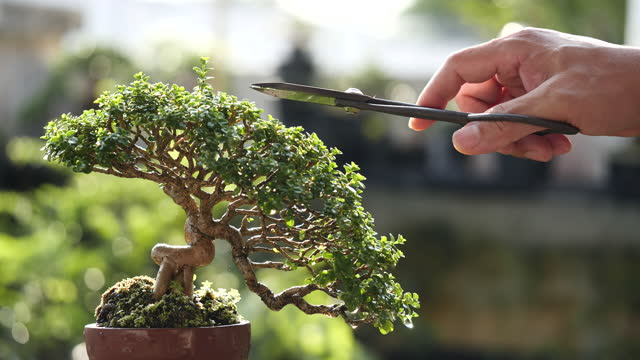If you’re looking to add a touch of elegance and natural beauty to your home or garden, bonsai palm trees are an excellent choice. These miniature versions of palm trees have their unique charm and require special care to thrive. In this comprehensive guide, we’ll explore everything you need to know about growing and caring for Palm tree Bonsai.
Unlike traditional bonsai trees, bonsai palm trees offer a distinct aesthetic appeal with their graceful fronds and tropical allure. They bring a sense of tranquility and sophistication to any space they adorn, making them a coveted choice among bonsai enthusiasts.
Growing bonsai palm trees requires a keen understanding of their unique features and specific care requirements.
In this guide, we’ll cover everything from understanding the fascination behind miniature palm bonsai and debunking common myths about Palm tree bonsai, to selecting the right palm tree species and providing ideal growing conditions.
We’ll also discuss care fundamentals, including watering techniques, fertilizer preferences, and the importance of pruning. Lastly, we’ll explore styling and pruning techniques and discuss the process of repotting and transplanting your bonsai palm tree.
Understanding Bonsai Palm Trees
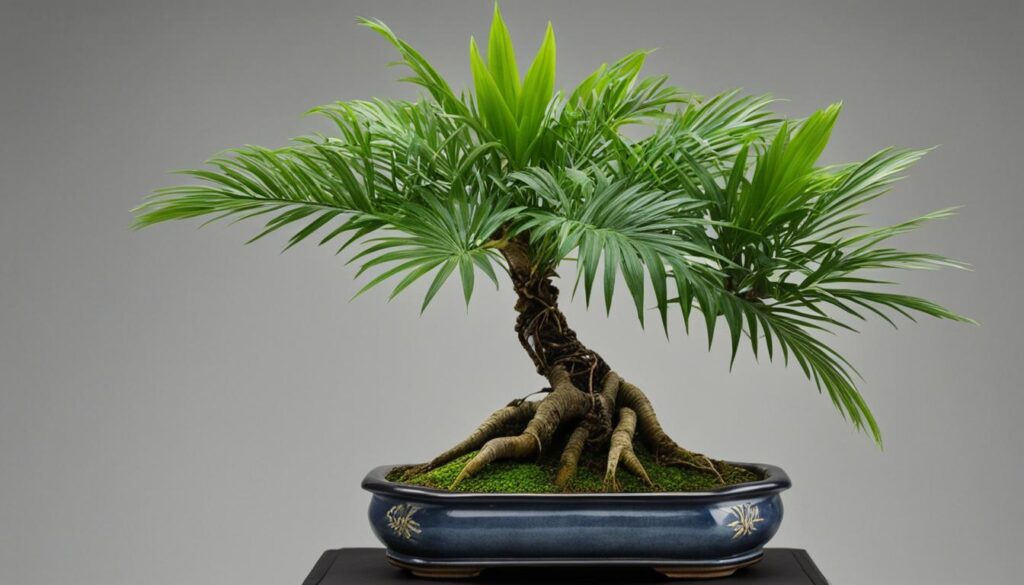
When it comes to bonsai trees, palm trees may not be the first variety that comes to mind. However, palm trees can indeed be transformed into stunning bonsai specimens. In this section, we will explore the unique fascination with miniature palm bonsai, debunk the myth surrounding the ability to bonsai a palm tree, and highlight the essential features that make bonsai palm trees a captivating choice for enthusiasts.
The Unique Fascination with Miniature Palm Bonsai
Miniature palm bonsai trees have a charm of their own. These tiny versions of majestic palm trees captivate with their delicate proportions, intricate foliage, and artistic appeal. They offer a different perspective on palm trees, showcasing their beauty in a compact form that fits perfectly within the artistry of bonsai.
Decoding the Myth: Can You Bonsai a Palm Tree?
Bonsai is typically done with woody plants; palms have a different growth pattern, making traditional bonsai techniques challenging. However, some enthusiasts experiment with miniature palms in containers for a similar effect. Success may vary based on the palm species and care provided.
Essential Features of Bonsai Palm Trees
Bonsai palm trees possess unique features that make them ideal for bonsai cultivation. Some of these features include:
- Feathery fronds: The elegant and delicate foliage of palm trees adds a touch of grace and beauty to the bonsai composition.
- Distinctive trunks: Palm tree trunks, with their unique textures and patterns, create visual interest and contribute to the overall aesthetic appeal of the bonsai.
- Vertical growth habits: The upright growth of many palm tree species makes them well-suited for the desired form and style of bonsai trees.
- Ability to withstand pruning: Palm trees have the remarkable ability to tolerate and recover from pruning, allowing for shaping and styling to create the desired bonsai silhouette.
Now that we have gained an understanding of the fascination with miniature palm bonsai and debunked the myth surrounding Palm tree bonsai, let’s dive deeper into the specific palm tree varieties that are suitable for bonsai cultivation in the next section.
Bonsai Palm Tree Varieties Suitable for Bonsai Cultivation
When it comes to bonsai palm trees, there are two popular varieties that are suitable for cultivation: the Ponytail Palm and the Sago Palm. Both of these palm trees offer unique characteristics and make stunning additions to any bonsai collection.
Ponytail Palm: A Succulent Disguised as a Palm
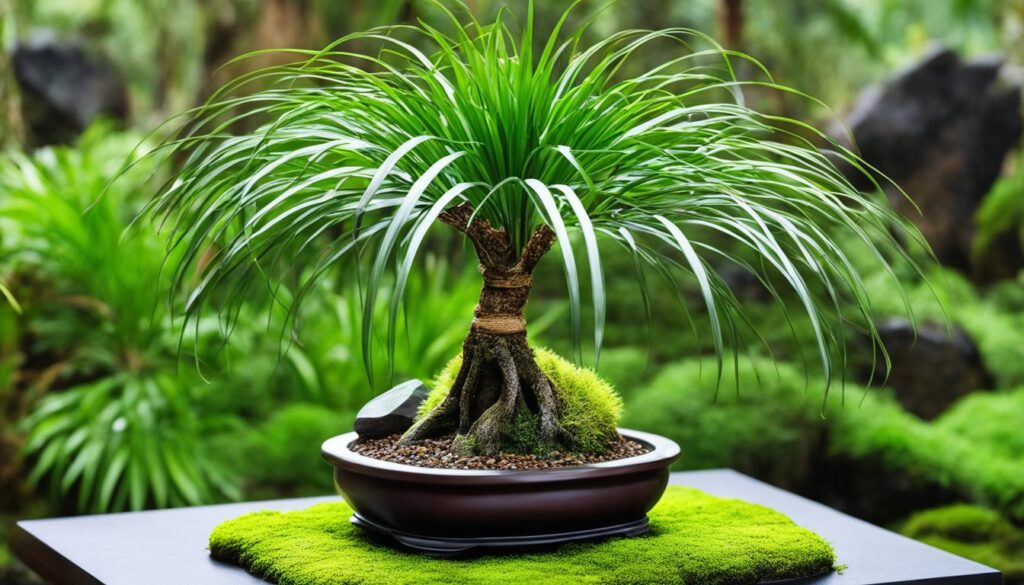
The Ponytail Palm, scientifically known as Beaucarnea recurvata, is a fascinating bonsai palm variety disguised as a palm tree due to its long, slender fronds that resemble palm leaves. However, it is not a true palm but actually a succulent. Its unique appearance and ability to store water in its swollen trunk make it a resilient and low-maintenance choice for bonsai enthusiasts.
The Ponytail Palm is known for its distinctive bulbous base, which stores water and nutrients, allowing it to withstand periods of drought. This feature adds an interesting flair to the bonsai’s overall aesthetic. The long, arching leaves cascade from the top, creating an elegant display. Pruning and styling techniques can be employed to accentuate its asymmetrical beauty and emphasize its natural form.
To ensure the health and vitality of the Ponytail Palm bonsai, it is essential to provide well-draining soil, moderate sunlight, and infrequent watering. This variety thrives in warm and dry environments and is well-suited to indoor bonsai cultivation.
Sago Palm Bonsai: A Prehistoric Touch to Modern Bonsai

The Sago Palm, scientifically referred to as Cycas revoluta, is another captivating bonsai palm variety that adds a prehistoric touch to modern bonsai collections. The Sago Palm bonsai is not a true palm tree but belongs to a primitive group of plants called cycads. Its unique appearance, resembling a palm tree with fern-like leaves, makes it a popular choice among bonsai enthusiasts.
Sago Palm bonsai have a rugged and textured trunk with layers of fronds that grow in a circular pattern at the ends. This distinctive feature creates a visually striking and dynamic display, especially when styled and pruned to enhance the trunk’s gnarled appearance. Its slow growth rate allows for intricate and precise shaping techniques to achieve a bonsai masterpiece.
For optimal growth and health, the Sago Palm requires a well-draining soil mix and a balance of bright indirect sunlight. As a tropical plant, it thrives in warm temperatures but can adapt to slightly cooler conditions. Care should be taken to protect the Sago Palm bonsai from frost and extreme temperatures.
| Bonsai Palm Variety | Scientific Name | Characteristics | Care Requirements |
|---|---|---|---|
| Ponytail Palm | Beaucarnea recurvata | – Resembles a palm, but is a succulent – Bulbous base for water storage – Long, arching leaves – Pruning and styling to accentuate natural form | – Well-draining soil – Moderate sunlight – Infrequent watering – Warm and dry environment |
| Sago Palm | Cycas revoluta | – Resembles a palm with fern-like leaves – Rugged and textured trunk – Circular frond growth – Gnarlable trunk for shaping | – Well-draining soil mix – Bright indirect sunlight – Protection from frost and extreme temperatures |
Selecting the Right Palm Tree Species for Bonsai
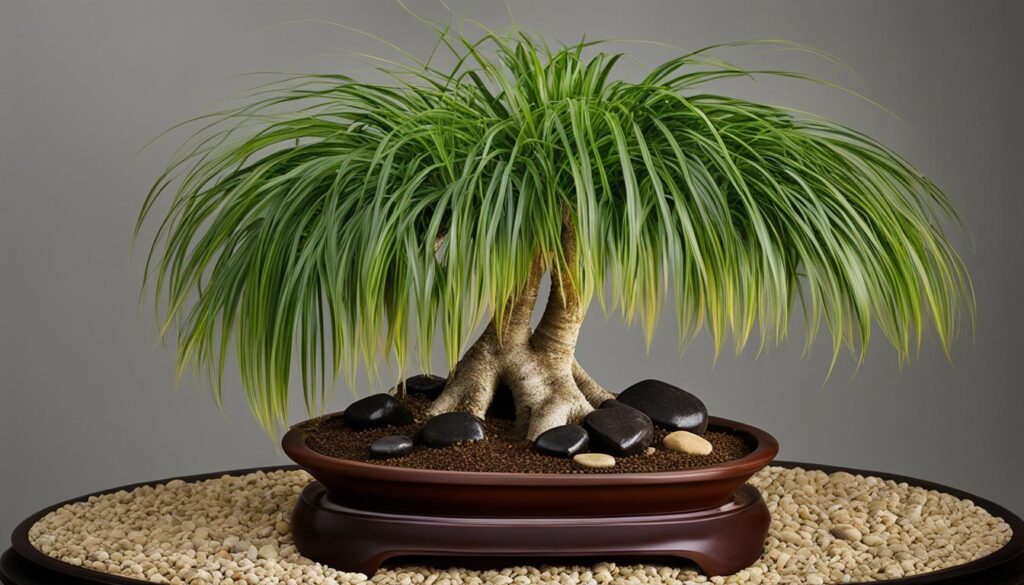
When it comes to creating a stunning bonsai palm tree, selecting the right palm tree species is crucial. Each species has its own unique characteristics that can contribute to the overall beauty and aesthetic appeal of your bonsai. In this section, we will explore two popular palm tree species that are perfect for bonsai cultivation: the ponytail palm and the sago palm.
Characteristics of the Ponytail Palm for Bonsai
The ponytail palm (Beaucarnea recurvata) is a striking palm tree that is known for its distinctive, bulbous trunk and long, slender leaves that cascade gracefully. This palm tree species is native to Mexico but has become popular among bonsai enthusiasts worldwide. Its unique appearance adds a touch of elegance and sophistication to any bonsai collection.
The ponytail palm is well-suited for bonsai cultivation due to its resilience and ability to thrive in a wide range of growing conditions. It can tolerate both bright sunlight and low light environments, making it a versatile choice for bonsai enthusiasts. Additionally, this palm tree species has a slow growth rate, allowing you to easily manage its size and shape.
Adapting the Sago Palm to the Bonsai Art Form
The sago palm (Cycas revoluta) is another palm tree species that can be adapted to the bonsai art form. Native to Japan, this prehistoric-looking palm tree features a unique crown of dark green, feather-like leaves and a sturdy trunk. Its timeless beauty and ability to withstand various growing conditions make it an excellent choice for bonsai enthusiasts.
When adapting the sago palm to the bonsai art form, it is important to consider its specific care requirements. This palm tree species prefers bright, indirect sunlight and well-draining soil. Regular watering is necessary to keep the soil moist but not overly saturated. Additionally, the sago palm bonsai requires occasional fertilization to ensure optimal growth and health.
By carefully selecting the right palm tree species for your bonsai, such as the ponytail palm and the sago palm, you can create captivating and unique bonsai trees that will stand out in any collection.
Ideal Conditions for Growing Bonsai Palm Trees
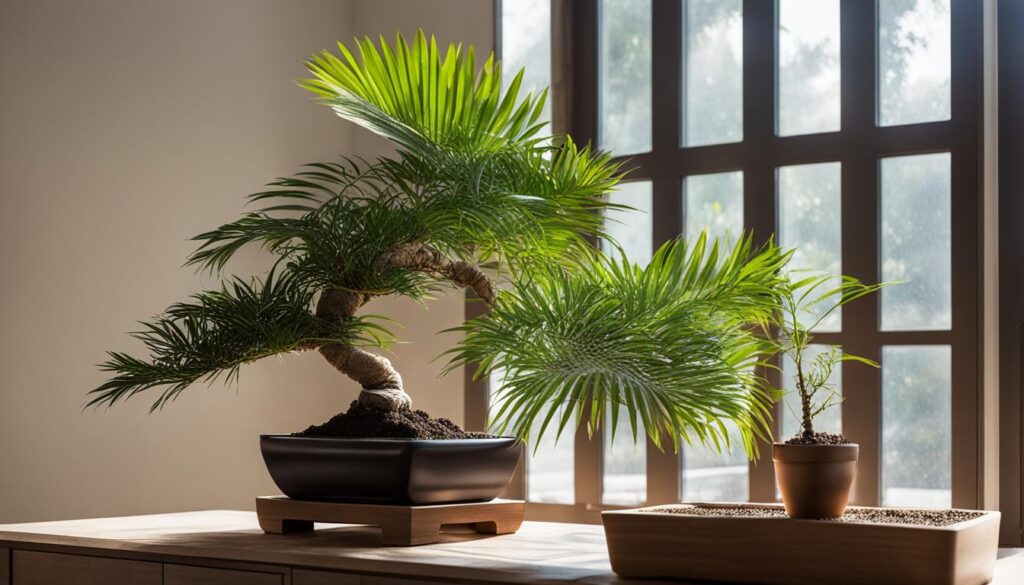
Creating the perfect growing environment is crucial to the success of your bonsai palm trees. To ensure their health and vitality, you need to understand the ideal conditions they require. Let’s explore the key factors that contribute to the optimal growth of Palm tree bonsai.
Lighting Requirements
Proper lighting is essential for the photosynthesis process, which is crucial for the growth and development of your bonsai palm trees. Most palm species thrive in bright, indirect sunlight.
Place your bonsai palm tree in a location where it can receive at least 4-6 hours of bright, filtered sunlight each day. If you’re growing your Palm tree bonsai indoors, consider using artificial grow lights to supplement the natural light.
Temperature Preferences
Bonsai palm trees typically prefer warm and tropical climates. They thrive in temperatures ranging from 65°F to 85°F (18°C to 29°C) during the day, and slightly cooler temperatures around 55°F to 65°F (13°C to 18°C) at night.
It’s important to protect your bonsai palm tree from extreme temperature fluctuations and frost. If you live in a colder climate, consider bringing your Palm tree bonsai indoors during the winter months or providing additional insulation to prevent damage.
Humidity Levels
Bonsai palm trees thrive in environments with high humidity levels. To create the ideal humidity, place a humidity tray filled with water near your palm tree bonsai or use a humidifier to maintain a humidity level of around 50% to 70%.
Pro Tip: Mist the leaves of your bonsai palm tree regularly using a spray bottle to increase humidity and prevent them from drying out.
| Lighting Requirements | Temperature Preferences | Humidity Levels |
|---|---|---|
| Bright, indirect sunlight for 4-6 hours per day | Daytime temperature: 65°F to 85°F (18°C to 29°C) Nighttime temperature: 55°F to 65°F (13°C to 18°C) | Humidity level: 50% to 70% |
By providing the ideal conditions of lighting, temperature, and humidity for your bonsai palm trees, you can ensure their overall health and promote their growth and development. Remember to regularly monitor and adjust these factors to create a thriving environment for your beloved bonsai palm trees.
Bonsai Palm Tree Care Fundamentals
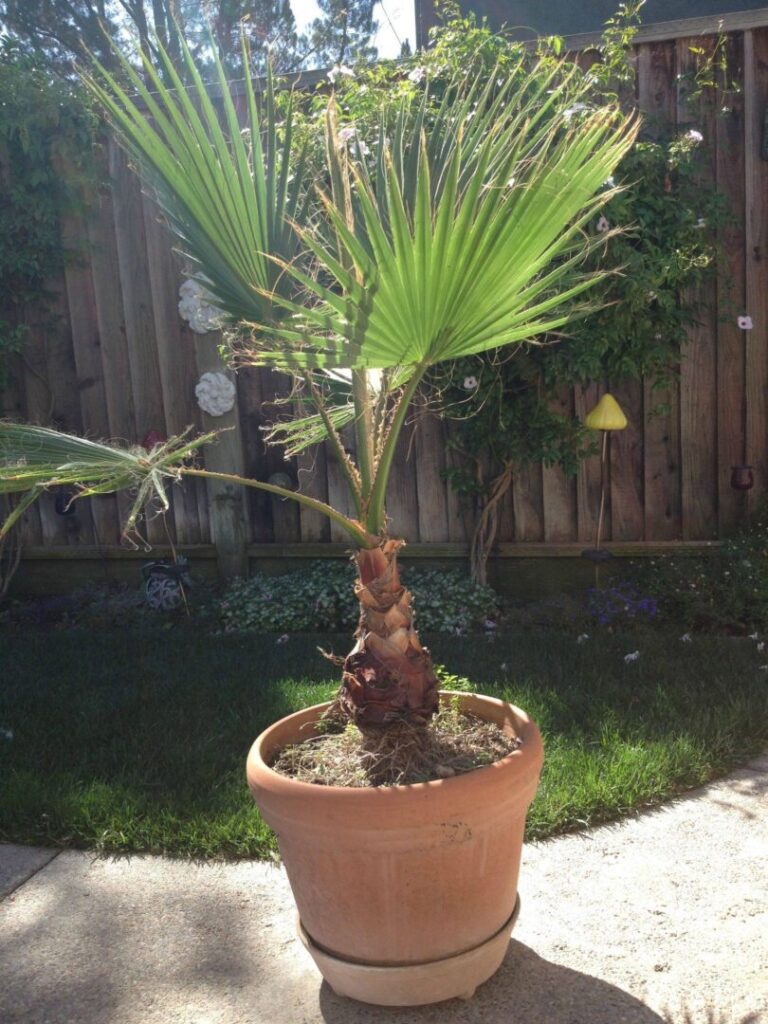
Proper care is essential for the health and well-being of your bonsai palm tree. In this section, we will explore the fundamental practices that are crucial for maintaining a thriving Palm tree bonsai. From watering and feeding to pruning and avoiding overwatering, these care fundamentals will help you ensure the longevity and beauty of your bonsai palm tree.
Watering Bonsai Palm Trees: How Much and How Often
Watering is a critical aspect of bonsai palm tree care. It is important to strike a balance between keeping the tree hydrated and avoiding overwatering, which can lead to root rot. As a general rule, water your bonsai palm tree when the top inch of the soil feels slightly dry. Use a watering can or a gentle spray to moisten the entire root ball, making sure not to leave any dry spots.
Feeding Your Bonsai: Fertilizer Preferences of Palm Species
Fertilizing your bonsai palm tree is essential for providing it with the nutrients it needs to grow and thrive. Different palm species have specific fertilizer preferences, so it is important to choose a fertilizer that is suitable for your particular Palm tree bonsai. Generally, opt for a balanced organic fertilizer with a ratio of 10-10-10 or a palm-specific fertilizer. During the growing season, fertilize your bonsai palm tree every two to three weeks, following the instructions on the fertilizer packaging.
Pruning Techniques for Shaping a Bonsai Palm Tree
Pruning plays a crucial role in shaping and maintaining the desired form of your bonsai palm tree. Start by removing any dead, damaged, or overcrowded branches. Use sharp pruning shears to make clean cuts at the base of the branch or at a bud or leaf node. To enhance the bonsai aesthetic, selectively prune branches to create an open and balanced canopy. Regular pruning will help promote growth and maintain the tree’s desired shape.
Avoiding Overwatering: Crucial for Palm Tree Health
Overwatering is one of the most common mistakes in bonsai palm tree care. Excessive moisture can lead to root rot, compromising the health and overall well-being of the palm tree. To avoid overwatering, make sure the bonsai pot has proper drainage holes to allow excess water to escape. Additionally, carefully monitor the moisture level of the soil and adjust your watering frequency accordingly. Remember, it’s better to slightly underwater than to overwater your bonsai palm tree.
| Watering Guidelines | Fertilizer Preferences | Pruning Techniques | Avoiding Overwatering |
|---|---|---|---|
| Water when the top inch is slightly dry | Choose balanced organic fertilizer or palm-specific fertilizer | Remove dead or damaged branches, selectively prune for shape | Ensure proper drainage, monitor soil moisture, avoid excessive watering |
| Avoid overwatering to prevent root rot | Fertilize every two to three weeks during the growing season | Use sharp pruning shears for clean cuts | Slightly underwater rather than overwater |
Styling and Pruning Bonsai Palm Trees
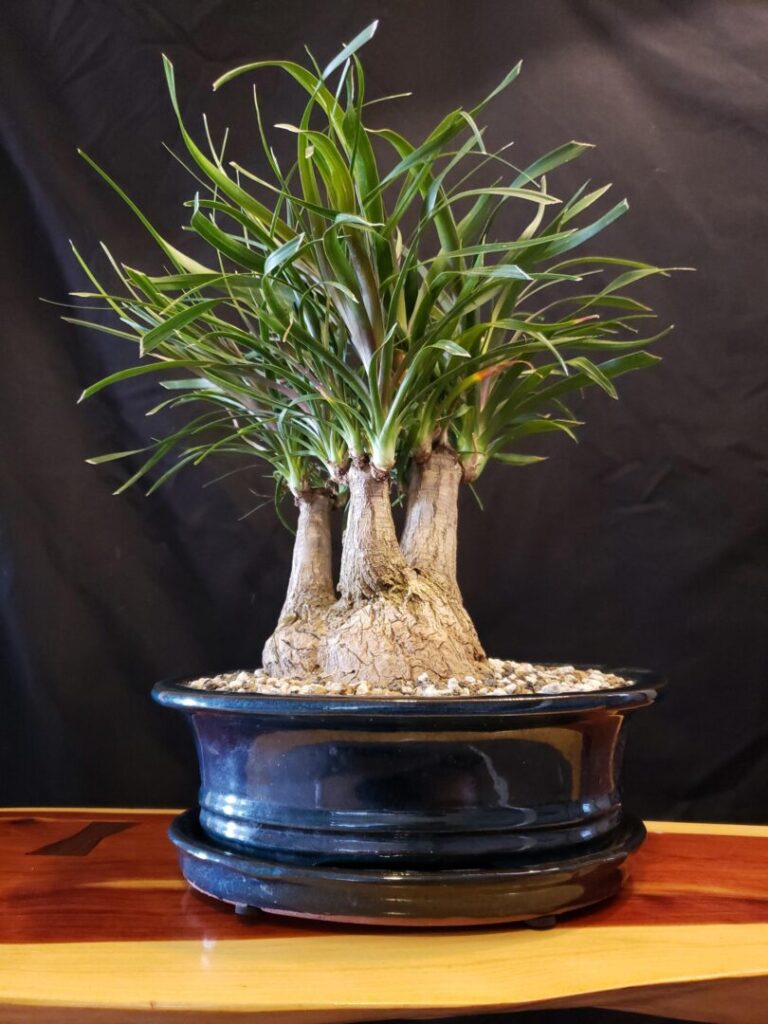
When it comes to bonsai palm trees, styling and pruning are essential techniques that allow you to shape and maintain the desired aesthetic. By harnessing these practices, you can create stunning bonsai palm trees that captivate with their elegance and beauty.
Styling bonsai palm trees involves guiding the growth of the tree to achieve a specific shape or form. This can be done through wiring, trimming, and careful manipulation of the branches and foliage. By utilizing these techniques, you can create unique and artistic compositions that showcase the palm tree’s natural beauty in a miniature form.
Pruning, on the other hand, is crucial for maintaining the health and overall structure of the bonsai palm tree. Regular pruning helps eliminate unwanted or excess growth, allowing the tree to allocate its resources more efficiently. It also helps maintain the desired size and proportions, preventing the tree from becoming overgrown.
When pruning bonsai palm trees, it’s vital to consider the tree’s growth patterns, as different palm species may require specific pruning approaches. By understanding the unique characteristics of each palm species, you can effectively shape and prune the tree to enhance its visual appeal.
“Styling and pruning are essential techniques that allow you to shape and maintain the desired aesthetic of bonsai palm trees.”
Whether you’re a beginner or an experienced bonsai enthusiast, it’s essential to approach styling and pruning with care and patience. Always consider the natural growth patterns of the palm tree and aim to create a harmonious balance between its artistic form and its overall health.
By mastering the art of styling and pruning, you can transform your Palm tree bonsai into living works of art that showcase the elegance and beauty of nature in miniature form.
| Benefits of Styling and Pruning Bonsai Palm Trees | Techniques |
|---|---|
| Enhances the visual appeal of the bonsai palm tree | Wiring |
| Maintains the overall health and structure of the tree | Trimming |
| Creates a harmonious balance between artistry and nature | Branch manipulation |
Repotting and Transplanting Your Bonsai Palm Tree

As your bonsai palm tree grows, it will eventually outgrow its current pot or require a fresh soil mix. Repotting is an essential step in maintaining the health and vitality of your palm bonsai. It allows for proper root growth, prevents overcrowding, and ensures optimal nutrient absorption.
When should you repot your bonsai palm tree? Generally, it is recommended to repot every two to three years or when you notice the roots becoming tightly packed. The best time to perform this procedure is during early spring when the tree is entering its active growth phase.
To repot your bonsai palm tree, start by gently removing it from its current pot. Carefully untangle the roots and trim any extra-long or damaged ones. Prepare a new pot with fresh, well-draining soil, specifically formulated for bonsai trees. Position the tree in the center of the pot, ensuring that the nebari (root flare) is visible. Fill the pot with soil, compacting it gently around the roots. Water the tree thoroughly and place it in a shaded area for a few weeks to allow for root recovery.
Learn more about Bonsai Soil: Best Soil for Bonsai: Top Mixes Reviewed
Transplanting a bonsai palm tree, on the other hand, involves a more significant move, such as changing it to a larger pot or planting it in the ground. This should be done sparingly and only when necessary. When transplanting, make sure to carefully retain as much of the root system as possible, as this will minimize transplant shock. Follow the same steps as repotting, but make accommodations for the larger size of the new container or the ground, ensuring proper spacing and healthy soil conditions.



